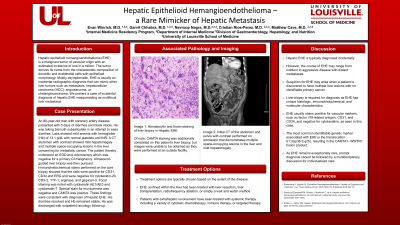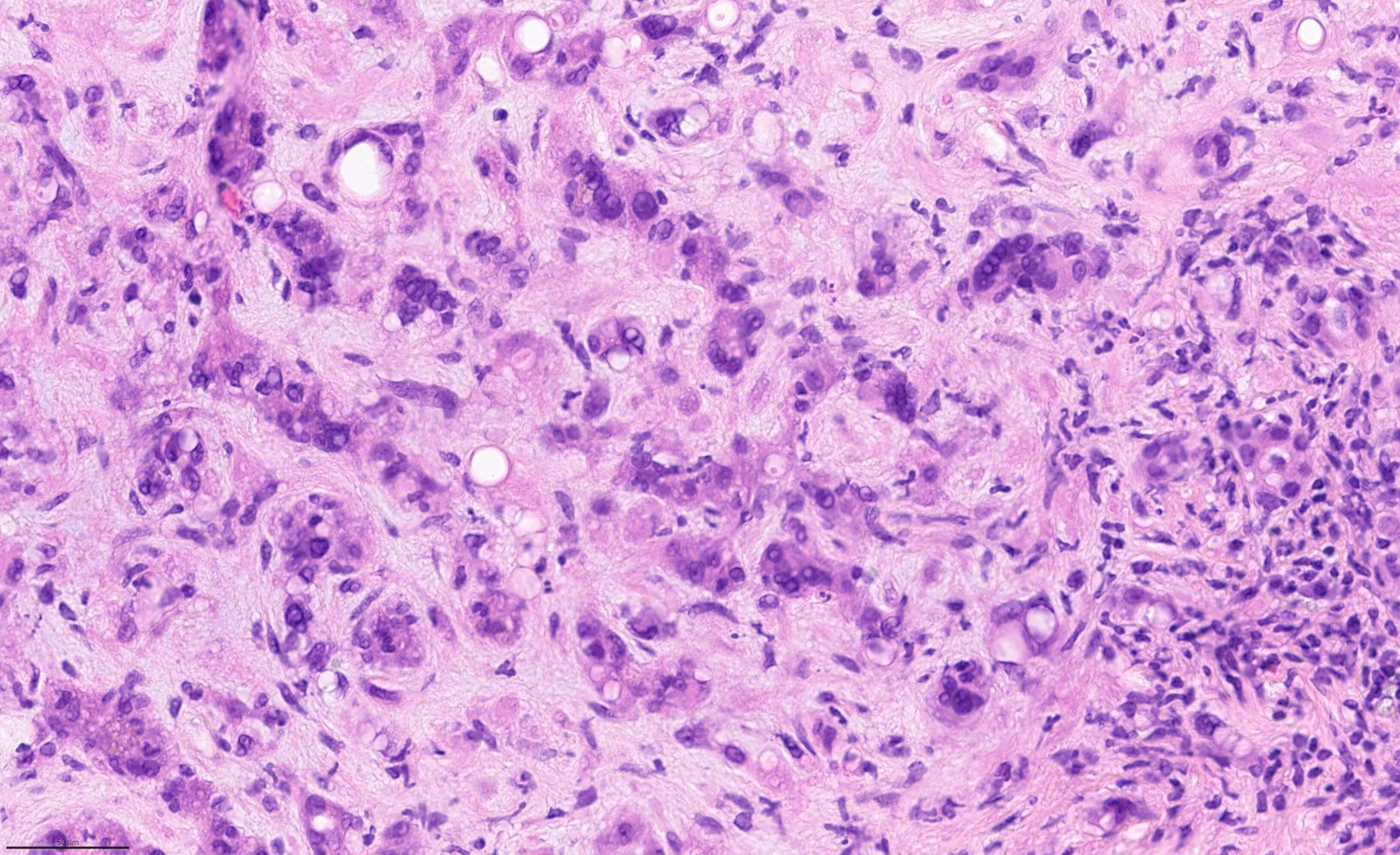Back


Poster Session D - Tuesday Morning
Category: Liver
D0557 - Hepatic Epithelioid Hemangioendothelioma – A Rare Mimicker of Hepatic Metastasis
Tuesday, October 25, 2022
10:00 AM – 12:00 PM ET
Location: Crown Ballroom

Has Audio

Evan Winrich, MD
University of Louisville
Louisville, KY
Presenting Author(s)
Evan Winrich, MD, Garvit Chhabra, MD, Navroop Nagra, MD, Cristian Rios Perez, MD, Ziyan Silah, MD, Matthew Cave, MD
University of Louisville, Louisville, KY
Introduction: Hepatic epithelioid hemangioendothelioma (EHE) is a malignant tumor of vascular origin with an estimated incidence of one in a million. The tumor derives its name from the characteristic composition of dendritic and endothelial cells with epithelioid morphology. Mostly asymptomatic, EHE is usually an incidental radiographic diagnosis that can mimic other liver tumors such as metastasis, hepatocellular carcinoma (HCC), angiosarcoma, or cholangiocarcinoma. We present a case of incidental diagnosis of hepatic EHE masquerading as multifocal liver metastasis.
Case Description/Methods: An 80-year-old man with coronary artery disease presented with 5 days of diarrhea and black stools. He was taking bismuth subsalicylate in an attempt to ease diarrhea. Labs showed mild anemia with hemoglobin (Hb) of 13.1 g/dL with normal platelets and INR. A CT abdomen with contrast showed mild hepatomegaly and multiple space-occupying lesions in the liver concerning for metastatic cancer. The patient thereby underwent an EGD and colonoscopy which was negative for a primary GI malignancy. Ultrasound-guided liver biopsy was then pursued. Immunohistochemical stains performed on the core biopsy showed that the cells were positive for CD31, CD34 and ERG and were negative for cytokeratin-20, CDX-2, TTF-1, arginase, and glypican-3. Focal staining was noted with cytokeratin AE1/AE3 and cytokeratin-7. Special stain for mucicarmine was negative. These findings were consistent with diagnosis of hepatic EHE. His diarrhea resolved and Hb remained stable. He was discharged with outpatient oncology follow-up.
Discussion: Hepatic EHE is typically diagnosed incidentally. However, the course of EHE may range from indolent to aggressive disease with distant metastases. Suspicion for EHE may arise when a patient is discovered to have multiple liver lesions with no identifiable primary cancer. Liver biopsy is required for diagnosis as EHE has unique histologic, immunohistochemical, and molecular characteristics. Treatment options are typically chosen based on the extent of the disease. EHE confined within the liver has been treated with liver resection, liver transplantation, radiofrequency ablation, or simply a wait and watch method. Patients with extrahepatic involvement have been treated with systemic therapy including a variety of cytotoxic chemotherapy, immune therapy, or targeted therapy. As EHE remains exceptionally rare, prompt diagnosis should be followed by a multidisciplinary discussion for individualized care.

Disclosures:
Evan Winrich, MD, Garvit Chhabra, MD, Navroop Nagra, MD, Cristian Rios Perez, MD, Ziyan Silah, MD, Matthew Cave, MD. D0557 - Hepatic Epithelioid Hemangioendothelioma – A Rare Mimicker of Hepatic Metastasis, ACG 2022 Annual Scientific Meeting Abstracts. Charlotte, NC: American College of Gastroenterology.
University of Louisville, Louisville, KY
Introduction: Hepatic epithelioid hemangioendothelioma (EHE) is a malignant tumor of vascular origin with an estimated incidence of one in a million. The tumor derives its name from the characteristic composition of dendritic and endothelial cells with epithelioid morphology. Mostly asymptomatic, EHE is usually an incidental radiographic diagnosis that can mimic other liver tumors such as metastasis, hepatocellular carcinoma (HCC), angiosarcoma, or cholangiocarcinoma. We present a case of incidental diagnosis of hepatic EHE masquerading as multifocal liver metastasis.
Case Description/Methods: An 80-year-old man with coronary artery disease presented with 5 days of diarrhea and black stools. He was taking bismuth subsalicylate in an attempt to ease diarrhea. Labs showed mild anemia with hemoglobin (Hb) of 13.1 g/dL with normal platelets and INR. A CT abdomen with contrast showed mild hepatomegaly and multiple space-occupying lesions in the liver concerning for metastatic cancer. The patient thereby underwent an EGD and colonoscopy which was negative for a primary GI malignancy. Ultrasound-guided liver biopsy was then pursued. Immunohistochemical stains performed on the core biopsy showed that the cells were positive for CD31, CD34 and ERG and were negative for cytokeratin-20, CDX-2, TTF-1, arginase, and glypican-3. Focal staining was noted with cytokeratin AE1/AE3 and cytokeratin-7. Special stain for mucicarmine was negative. These findings were consistent with diagnosis of hepatic EHE. His diarrhea resolved and Hb remained stable. He was discharged with outpatient oncology follow-up.
Discussion: Hepatic EHE is typically diagnosed incidentally. However, the course of EHE may range from indolent to aggressive disease with distant metastases. Suspicion for EHE may arise when a patient is discovered to have multiple liver lesions with no identifiable primary cancer. Liver biopsy is required for diagnosis as EHE has unique histologic, immunohistochemical, and molecular characteristics. Treatment options are typically chosen based on the extent of the disease. EHE confined within the liver has been treated with liver resection, liver transplantation, radiofrequency ablation, or simply a wait and watch method. Patients with extrahepatic involvement have been treated with systemic therapy including a variety of cytotoxic chemotherapy, immune therapy, or targeted therapy. As EHE remains exceptionally rare, prompt diagnosis should be followed by a multidisciplinary discussion for individualized care.

Figure: Hematoxylin and Eosin staining of liver biopsy in Hepatic EHE
Disclosures:
Evan Winrich indicated no relevant financial relationships.
Garvit Chhabra indicated no relevant financial relationships.
Navroop Nagra indicated no relevant financial relationships.
Cristian Rios Perez indicated no relevant financial relationships.
Ziyan Silah indicated no relevant financial relationships.
Matthew Cave indicated no relevant financial relationships.
Evan Winrich, MD, Garvit Chhabra, MD, Navroop Nagra, MD, Cristian Rios Perez, MD, Ziyan Silah, MD, Matthew Cave, MD. D0557 - Hepatic Epithelioid Hemangioendothelioma – A Rare Mimicker of Hepatic Metastasis, ACG 2022 Annual Scientific Meeting Abstracts. Charlotte, NC: American College of Gastroenterology.
